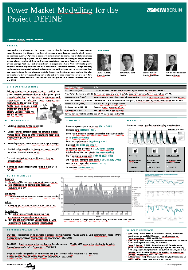Electricity Market Analysis - DEFINE
Main menu
Electricity Market Analysis
This section comprises 2 work-packages. The main beneficiaries are DIW and ESEA.
1. Elaborations on the Electricity Market Model (WP2)
Objectives
Development of two model frameworks which depicts the interdependencies between e-mobility roll-out and European electricity grids
Creation of power market models as a tool to approximate the functioning of the core models
Operation of EV as a switchable load
Elecetricity grid representation
International trade patterns
Creation of a common and comparable model framework for Germany and Austria
Description
Task 2.1: Linearisation of binary constraints
A major complexity of unit commitment modes derives from the fact that unit commitment is naturally a binary decision, with power plants having either on- or off-status. To account for this binary nature, integer variables are usually used in simulation models.
Task 2.2: Inclusion of EV demand
The EV-Demand will be simulated through typical user patterns of passenger cars.
Task 2.3: Inclusion of storage management
Electric vehicles can possibly form an important role in determining the back-up capacity of electricity grids to deal with increased renewable input. EV batteries can be modeled as a potential storage option for utilities, both as bi-directional storage (V2G) or mono-directional storage option.
Task 2.4: Load Flow Model mainly carried out by ESEA for Austria and likely Germany
A model structure that allows for a quantification of the impact of EV charging on power grid congestion and system reliability is built. This analysis is carried out at the high voltage level.
Task 2.5: Include consumer electricity prices mainly carried out by ESEA for Austria and likely Germany
EV, load infrastructure roll-out or the extension of capacities will put upward pressure on electricity prices, therefore a reallocation of costs will be necessary. The model developed by ESEA is ideally suited for estimating the overall effect of e-mobility on market electricity prices.
2. Completion of Electricity Market Model & Application (WP7)
Objectives
Feed the electricity market model structure from WP2 with required data
Validation of the model
Execution and analysis of the model under the scenarios built in WP4
Description
Task 7.1: Feed the electricity market model with data
Deals with the interdependencies between an e-mobility roll out and European electricity markets and the development of model frameworks to address these interdependencies for Austria and Germany.
Task 7.2: Find and correct errors
This work consistis mainly in debugging errors, irregularities and unrealistic relations. The aim is that the model outcomes replicate reral world behaviour.
Task 7.3: Execution and analysis of the model
Deals with the calibration, validation and application of the bottom-up electricity market model. Run the model consecutively for each scenario and analyse the results.
INSIDE the
WORKFLOW
